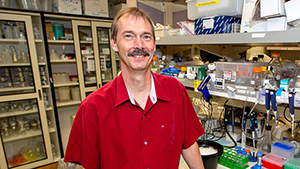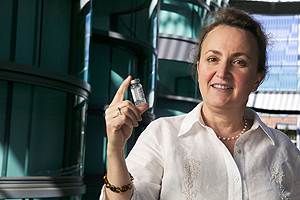April 21, 2014 - By Ranjini Raghunath

SPARK helped Craig Garner, whose research team discovered that a compound could help restore learning abilities in children with Down syndrome, advance the findings from the early stages to the proof-of-concept stage. Credit: Norbert von der Groeben
Seven years ago, Stanford neuroscientist Craig Garner, PhD, was in a dilemma.
His lab's research on Down syndrome had just borne fruit: a discovery that could help restore learning abilities in the millions of children who suffer from the genetic condition.
But Garner, a professor of psychiatry and behavioral sciences, had a hard time getting companies interested in the discovery.
Instead of targeting the cause of the condition — an intricate interplay of more than 200 genes — Garner and colleagues had focused on the genes' effect on nerve circuits. They showed, for the first time, that certain inhibitory nerve circuits were keeping other nerve circuits involved in learning "offline." They also found that compounds belonging to a class of drugs called GABA-A antagonists could block these inhibitory nerve circuits and restore normal learning abilities in mice with the equivalent of Down syndrome.
It was an exciting finding for two reasons: No other treatment for Down syndrome had worked before, and GABA-A blocking compounds had been around for decades, used previously as stimulants and for treating disorders such as dementia.
But to Garner's disappointment, drug companies didn't seem to be interested, "partly because it was a radically different idea, and partly because companies want to know that the drug is both safe and effective," he said. This particular compound was known to cause seizures and other side effects at high doses.
Navigating the 'valley of death'
Garner struggled with the same questions that many academic researchers face: how to get companies interested in early-stage discoveries, and how to traverse the "valley of death" between drug discovery and development.

Daria Mochly-Rosen founded SPARK, a hands-on training program aimed at helping scientists take their discoveries from their labs to the pharmaceutical industry's doorstep.
Fortunately for Garner, the timing of his discovery couldn't have been better.
Just a year before, another Stanford researcher, Daria Mochly-Rosen, PhD, had founded SPARK, a hands-on training program aimed at helping scientists take their discoveries from their labs to the pharmaceutical industry's doorstep.
A professor of chemical and systems biology, Mochly-Rosen was motivated by a similar struggle to get her research finding picked up by drug companies. She was frustrated that they weren't showing interest in a potentially life-saving treatment.
The one-year leave of absence she took to start her own company, KAI Pharmaceuticals, was an eye-opener. "I was shocked to learn that there are more ways to fail than succeed, and that it isn't just a matter of following a logical path like we do in academic research," she said. "There are certain skills and know-how in industry that we in academia just do not share."
Mochly-Rosen also realized that academic training doesn't always impart the skills and knowledge students need to succeed in industry or in other roles. "We just train them to be us," she said.
After returning to Stanford, she founded SPARK in 2006. A year later, she was joined by Kevin Grimes, MD, MBA, who was then senior director of clinical research at KAI Pharmaceuticals. Together with industry experts who served as SPARK advisers, such as Juan Jaen, PhD, and Eric Gordon, PhD, they scoured the hundreds of patents submitted to Stanford's Office of Technology Licensing and picked a handful of projects they felt could benefit from a program like SPARK. Garner's finding was among the first projects shortlisted.
"They came to me and said, 'this is a really cool problem, it has a high social impact and we'd love to try to help you,'" Garner said.
That was seven years ago.
Today, SPARK continues to help Stanford researchers realize the full potential of their academic inventions. The program provides education, mentorship and modest funding to help researchers take their discoveries from the early stages — at which point companies may consider them premature or risky — to the proof-of-concept stage — "where companies can take a look at it and say, 'now it is more than a paper in a good journal; now it is a project,'" said Mochly-Rosen, who is also the George D. Smith Professor in Translational Medicine.
How it works
Each year, 10 or 12 projects are picked from nearly 200 applications by a committee of SPARK advisers and given funding of up to $50,000 per year over two years.
"It could be a clinician who found a drug that can be repurposed for a new indication, or a basic researcher who knocked out a gene and is wondering how to use the phenotype to treat a disease, or a physician interested in a diagnostic test but doesn't know where to start," Mochly-Rosen explained.
Since SPARK'S founding, 51 research teams have "graduated" from the program. More than half of its projects have been licensed or have advanced to clinical use, or both, in sharp contrast to the pharmaceutical industry's own success rate of approximately 5 percent.
With SPARK's support, a research team, led by dermatologist Alfred Lane, MD, has received a fundable score on a Food and Drug Administration orphan grant for phase-2 trials of a repurposed drug to treat lymphatic malformations that disfigure and disable children. Another team, led by immunologists William Robinson, MD, PhD, and Jeremy Sokolove, MD, is testing a combination of drugs to treat early stages of cartilage loss and joint degeneration in bone arthritis. Findings of a third research team led by bioinformatics expert Atul Butte, MD, PhD, and Bruce Ling, PhD — biomarkers for detecting dangerously high blood pressure in pregnancy — have already been picked up for licensing by a start-up biotechnology company.
Former SPARK beneficiaries, or "SPARKees," have credited the program with helping them get research grants, publish papers in reputable journals and even land a tenure-track position, Mochly-Rosen said.
Understanding the drug-development process
During weekly seminars, SPARKees discuss and listen to lectures on various facets of drug development — from safety testing and quality control to intellectual property, conflicts of interest and licensing. They also present quarterly project updates and receive feedback and insights from experts. SPARK advisers include industry veterans with decades of experience, such as Steve Schow, PhD, vice president of research and development at Telik Inc.; Daniel Erlanson, PhD, co-founder and president of Carmot Therapeutics; and Robert Lum, PhD, Medivation Inc.'s associate director of process development.
"We were told how and what to test for: safety, efficacy, biometrics — how you would know if the drug is working or not," Garner recalled. "They also taught us what it means to develop and license a drug, how to get investments and how to start a company."
These and other insights helped Garner and his team define the safety levels, minimum dosage and best active times for their repurposed drug. Garner later started his own company, Balance Therapeutics, to develop the drug, which is currently undergoing phase-2 clinical trials in Australia with 90 Down's syndrome patients.
Such learning lies at the heart of the program, with its primary goal of educating academic scientists about the process of drug development, said Mochly-Rosen. "There is no way that if you bring people to a room every week for two years they will not learn something," she said. "Even after eight years in SPARK, I am learning something new every week."
Early SPARKees were mostly faculty members, but a few years ago the program began considering applications from postdoctoral scholars and graduate students and funding some of their projects. Many of these applications come from students who have enrolled in drug-development classes in the Chemical and Systems Biology Department. One such student is currently working on testing an alternative botanical treatment for an inflammatory bowel disease.
Matching students with mentors who can guide their progress is another benefit of the SPARK program, Garner said. Once a SPARKee himself, he now advises a student group working on a treatment for a lysosomal storage disorder.
SPARKing others
In recent years, the program has sparked similar and identical initiatives outside Stanford, fulfilling another of Mochly-Rosen's original visions for the program. Several universities in the United States — in Vermont, New York and California — and across the globe — in Taiwan, Japan and South Korea — have now launched their own SPARK programs. And many more are in the pipeline.
Mochly-Rosen and Grimes also published a book this winter summarizing the drug development process: A Practical Guide to Drug Development in Academia: The Spark Approach.
Mochly-Rosen's vision for SPARK extends beyond the confines of an educational institution. She hopes one day to be able to integrate various institutions' SPARK programs under a single brand that will encourage and attract more companies to invest in early-stage discoveries, and open the doors for better academia-industry collaborations.
A yearly SPARK conference that would showcase successful projects from around the world to enable faster licensing is another goal, she said.
Mochly-Rosen ultimately hopes that programs like SPARK would help make translational research "second nature" to scientists "so that they can come up with better drugs faster," she said.
"We have a social responsibility to bring our discoveries as far as we can to patients," she said.
This year, SPARK applications will be accepted starting in late June. The deadline will be in September.
SPARK is supported by the dean's office, the Stanford Child Health Research Institute, NIH Global Health, and Spectrum, Stanford's NIH Clinical and Translational Science Award.
About Stanford Medicine
Stanford Medicine is an integrated academic health system comprising the Stanford School of Medicine and adult and pediatric health care delivery systems. Together, they harness the full potential of biomedicine through collaborative research, education and clinical care for patients. For more information, please visit med.stanford.edu.